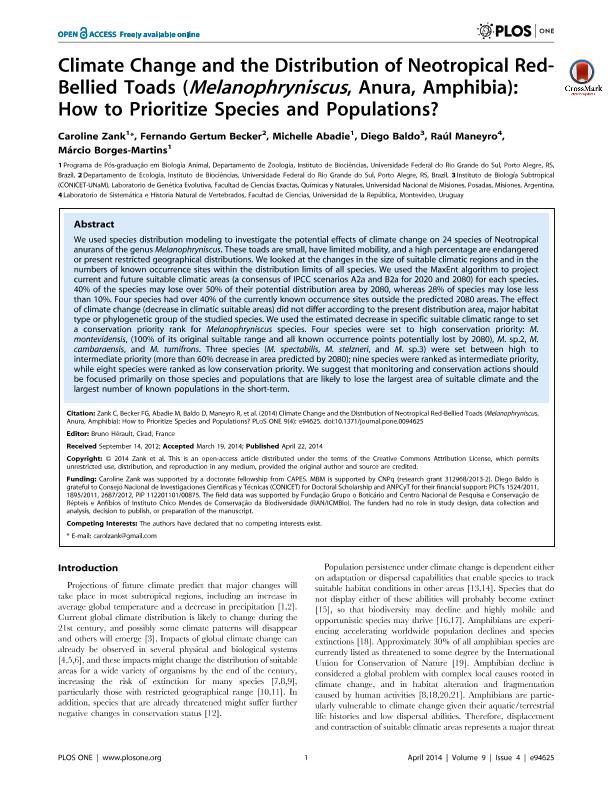Mostrar el registro sencillo del ítem
dc.contributor.author
Zank, Caroline
dc.contributor.author
Becker, Fernando Gertum
dc.contributor.author
Abadie, Michelle
dc.contributor.author
Baldo, Juan Diego

dc.contributor.author
Maneyro, Raúl
dc.contributor.author
Borges Martins, Márcio
dc.date.available
2016-12-13T20:23:12Z
dc.date.issued
2014-04
dc.identifier.citation
Zank, Caroline; Becker, Fernando Gertum; Abadie, Michelle; Baldo, Juan Diego; Maneyro, Raúl; et al.; Climate change in the distribution of neotropical redbelly toads (Melanophryniscus, Anura, Amphibia): How to prioritize species and populations?; Public Library Of Science; Plos One; 9; 4; 4-2014; 1-11
dc.identifier.issn
1932-6203
dc.identifier.uri
http://hdl.handle.net/11336/9302
dc.description.abstract
We used species distribution modeling to investigate the potential effects of climate change on 24 species of Neotropical anurans of the genus Melanophryniscus. These toads are small, have limited mobility, and a high percentage are endangered or present restricted geographical distributions. We looked at the changes in the size of suitable climatic regions and in the numbers of known occurrence sites within the distribution limits of all species. We used the MaxEnt algorithm to project current and future suitable climatic areas (a consensus of IPCC scenarios A2a and B2a for 2020 and 2080) for each species. 40% of the species may lose over 50% of their potential distribution area by 2080, whereas 28% of species may lose less than 10%. Four species had over 40% of the currently known occurrence sites outside the predicted 2080 areas. The effect of climate change (decrease in climatic suitable areas) did not differ according to the present distribution area, major habitat type or phylogenetic group of the studied species. We used the estimated decrease in specific suitable climatic range to set a conservation priority rank for Melanophryniscus species. Four species were set to high conservation priority: M. montevidensis, (100% of its original suitable range and all known occurrence points potentially lost by 2080), M. sp.2, M. cambaraensis and M. tumifrons. Three species (M. spectabilis, M. stelzneri and M. sp.3) were set between high to intermediate priority (more than 60% decrease in area predicted by 2080); nine species were ranked as intermediate priority, while eight species were ranked as low conservation priority. We suggest that monitoring and conservation actions should be focused primarily on those species and populations that are likely to lose the largest area of suitable climate and the largest number of known populations in the short-term.
dc.format
application/pdf
dc.language.iso
eng
dc.publisher
Public Library Of Science

dc.rights
info:eu-repo/semantics/openAccess
dc.rights.uri
https://creativecommons.org/licenses/by/2.5/ar/
dc.subject
Species Distribution Models
dc.subject
Global Change
dc.subject
Conservation
dc.subject
Suitable Climatic Areas
dc.subject
Rare Species.
dc.subject.classification
Zoología, Ornitología, Entomología, Etología

dc.subject.classification
Ciencias Biológicas

dc.subject.classification
CIENCIAS NATURALES Y EXACTAS

dc.title
Climate change in the distribution of neotropical redbelly toads (Melanophryniscus, Anura, Amphibia): How to prioritize species and populations?
dc.type
info:eu-repo/semantics/article
dc.type
info:ar-repo/semantics/artículo
dc.type
info:eu-repo/semantics/publishedVersion
dc.date.updated
2016-11-17T16:03:57Z
dc.journal.volume
9
dc.journal.number
4
dc.journal.pagination
1-11
dc.journal.pais
Estados Unidos

dc.journal.ciudad
San Francisco
dc.description.fil
Fil: Zank, Caroline. Universidade Federal do Rio Grande do Sul; Brasil
dc.description.fil
Fil: Becker, Fernando Gertum. Universidade Federal do Rio Grande do Sul; Brasil
dc.description.fil
Fil: Abadie, Michelle. Universidade Federal do Rio Grande do Sul; Brasil
dc.description.fil
Fil: Baldo, Juan Diego. Consejo Nacional de Investigaciones Científicas y Técnicas. Centro Científico Tecnológico Nordeste. Instituto de Biología Subtropical. Instituto de Biología Subtropical - Nodo Posadas; Argentina
dc.description.fil
Fil: Maneyro, Raúl. Universidad de la Republica; Uruguay
dc.description.fil
Fil: Borges Martins, Márcio. Universidade Federal do Rio Grande do Sul; Brasil
dc.journal.title
Plos One

dc.relation.alternativeid
info:eu-repo/semantics/altIdentifier/url/https://www.ncbi.nlm.nih.gov/pmc/articles/PMC3995645/
dc.relation.alternativeid
info:eu-repo/semantics/altIdentifier/url/http://journals.plos.org/plosone/article?id=10.1371/journal.pone.0094625
dc.relation.alternativeid
info:eu-repo/semantics/altIdentifier/url/http://dx.doi.org/10.1371/journal.pone.0094625
Archivos asociados
